NASA engineers will need to disassemble both of their Mars rovers to fix an electrical device which could have caused a catastrophic short circuit later in the mission. This delay will push the launch of the first rover a week to no earlier than June 6, with the second launching two weeks later as scheduled. The twin rovers will perform a series of geologic experiments on Mars to search for evidence of past water.
Russia’s President Vow’s Additional Space Station Support
During a video conference with the crew of the International Space Station on Saturday, Russian President Vladimir Putin said that they would send additional spacecraft during the US freeze on shuttle flights. “If it comes to it, we will look at the question of Russia taking on further work in the ISS.” A replacement 2-man crew is due to launch on April 26.
Six New Moons Found Around Jupiter
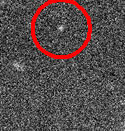
Image credit: University of Hawaii
Astronomers from the University of Hawaii have discovered six new moons for Jupiter, pushing the planet’s satellite count to 58 – the largest group of moons in the Solar System. These aren’t terribly big moons, though, only a kilometer or so across. The moons were discovered as part of an ongoing search using the world’s largest digital cameras at the Subaru and Canada-France-Hawaii telescopes atop Mauna Kea.
The majority of the new satellites were first seen in early February 2003 by Scott S. Sheppard and David C. Jewitt from the Institute for Astronomy, University of Hawaii along with Jan Kleyna of Cambridge University. The satellites were detected using the world’s two largest digital cameras at the Subaru (8.3 meter diameter) and Canada-France-Hawaii (3.6 meter diameter) telescopes atop Mauna Kea in Hawaii. Both telescopes and their imaging cameras represent the latest technology has to offer. Recoveries were performed at the University of Hawaii 2.2 meter with help from Yanga Fernandez and Henry Hsieh also from the University of Hawaii. Brian Marsden of the Harvard-Smithsonian Center for Astrophysics performed the orbit fitting for the new satellites.
The first 7 satellites were formally announced by the International Astronomical Union on Circular No. 8087 on March 4, 2003 while the eighth was announced on Circular No. 8088 on March 6, the 9th through 12th on Circular No. 8089 on March 7, S/2003 J13 through J20 were announced in April, and S/2003 J21 in May*. Except for S/2003 J20, all the new Jupiter satellites appear to have distant retrograde orbits (ie. their orbital rotation is opposite to Jupiter’s rotation) like the majority of the known irregular satellites of Jupiter. The satellite S/2003 J20 appears to be a prograde satellite dynamically distinct from any other known Jupiter satellite.
Original Source: IFA News Release
Astronauts Take Last Spacewalk for a While
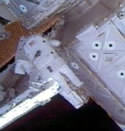
Image credit: NASA
Astronauts Ken Bowersox and Don Pettit spent more than six hours working outside the International Space Station today to wrap a few upgrades. Because NASA will be switching to two-astronaut teams shortly, this will likely be the last spacewalk for several months – one astronaut needs to stay on board the station during any walk for safety. The current crew has been on board since November, and was supposed to return some time in March, but the Columbia disaster has pushed their return back indefinitely.
Expedition 6 Commander Ken Bowersox and NASA Science Officer Don Pettit reconfigured critical power cables and continued the external outfitting of the International Space Station today during a 6 hour, 26 minute spacewalk designed to complete a number of get-ahead tasks for future ISS assembly.
Taking advantage of the final days of a three-man presence on the ISS before the new Expedition 7 crew is launched, Bowersox and Pettit began the second spacewalk of their increment at 7:40 a.m. CDT (1240 GMT). It was the second spacewalk for both Bowersox and Pettit, the 51st spacewalk for ISS assembly and maintenance and the 17th spacewalk staged from the U.S. Quest Airlock. Flight Engineer Nikolai Budarin helped the crew suit up and monitored ISS systems from inside the Destiny Laboratory during the excursion.
Bowersox and Pettit set out immediately to set up tools and tethers, and quickly went to work on separate tasks. Bowersox reconfigured electrical connectors at the interfaces between the Starboard Zero (S0) Truss and the two trusses flanking it, the Starboard One (S1) Truss and the Port 1 (P1) Truss. The connector work will insure that additional protection is in place to prevent the inadvertent release of the truss segments from the S0 Truss through the trusses? Bolt Bus Controller system. Bowersox also inspected a faulty heater cable on the P1 Truss Nitrogen Tank Assembly but found nothing unusual.
While that work was being conducted, Pettit replaced a power relay box in the Mobile Transporter railcar system, which has experienced some electrical problems in recent weeks.
Both spacewalkers then made their way to the Z1 (Zenith One) Truss, where they successfully rerouted power cables to two of the four Control Moment Gyros (CMGs) that provide orientation control for the ISS from the U.S. segment. One CMG failed almost a year ago, and the cable reconfiguration to CMGs # 2 and 3 will prevent both from being disabled in the unlikely event a power failure occurs. The ISS can be properly oriented with just two CMGs in operation. A replacement for the failed CMG will be flown to the ISS and installed on the first post-Columbia shuttle mission, STS-114.
Bowersox and Pettit pressed ahead to install two so-called Spool Positioning Devices on fluid quick disconnect lines for the heat exchanger on the Destiny Laboratory. The devices help keep internal seals and moving parts from experiencing internal leakage as ammonia flows through the station?s cooling system.
With that completed, the two station crewmembers ventured to the S1 Truss to secure a thermal cover on the truss? Radiator Beam Valve Module, which controls the flow of ammonia to the truss? heat-rejecting radiators.
One final task awaited Bowersox and Pettit — the deployment of a balky light stanchion for the handrail cart on the S1 Truss that would not unfurl during the previous spacewalk by the two crewmembers in January. The stanchion proved to be just as stubborn this time, but Pettit used a hammer to tap the stanchion free from its stowed position on the 10th try. A light was then installed on the stanchion, giving the truss the illuminating capability it needs to assist future spacewalkers.
With all of their work completed, Bowersox and Pettit retrieved some tools for future spacewalks from external locations and returned to Quest to complete their spacewalk at 2:06 p.m. CDT (1906 GMT).
The crew will spend a quiet day tomorrow relaxing before resuming its complement of scientific research and routine maintenance work on board the ISS Thursday.
Meanwhile, Expedition 7 Commander Yuri Malenchenko and Flight Engineer/NASA ISS Science Officer Ed Lu completed final preparations before traveling to the Baikonur Cosmodrome in Kazakhstan tomorrow from their training base in Star City, Russia to inspect the Soyuz TMA-2 vehicle in which they will be launched on April 26 to begin a six-month mission on the ISS.
Original Source: NASA News Release
Hubble Watches Star Erupt
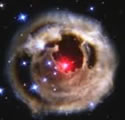
Image credit: Hubble
A recent set of images taken by the Hubble Space Telescope show a dull star that suddenly became 600,000 times brighter. The star, called V838 Monocerotis, is located 20,000 light-years from Earth and astronomers are unsure exactly why it flared up so brightly ? temporarily becoming the brightest star in the Milky Way. The outburst was similar to a nova, but unlike this fairly common occurrence, V838 didn’t slough off its outer layers.
In January 2002, a dull star in an obscure constellation suddenly became 600,000 times more luminous than our Sun, temporarily making it the brightest star in our Milky Way galaxy.
The mysterious star has long since faded back to obscurity, but observations by NASA’s Hubble Space Telescope of a phenomenon called a “light echo” have uncovered remarkable new features. These details promise to provide astronomers with a CAT-scan-like probe of the three-dimensional structure of shells of dust surrounding an aging star. The results appear tomorrow in the journal Nature.
“Like some past celebrities, this star had its 15 minutes of fame,” says Anne Kinney, director of NASA’s Astronomy and Physics program, Headquarters, Washington. “But its legacy continues as it unveils an eerie light show in space. Thankfully, NASA’s Hubble has a front row seat to this unique event in our galaxy.”
Light from a stellar explosion echoing off circumstellar dust in our Milky Way galaxy was last seen in 1936, long before Hubble was available to study the tidal wave of light and reveal the netherworld of dusty black interstellar space.
“As light from the outburst continues to reflect off the dust surrounding the star, we view continuously changing cross-sections of the dust envelope. Hubble’s view is so sharp that we can do an ‘astronomical cat-scan’ of the space around the star,” says the lead observer, astronomer Howard Bond of the Space Telescope Science Institute in Baltimore.
Bond and his team used the Hubble images to determine that the petulant star, called V838 Monocerotis (V838 Mon) is about 20,000 light-years from Earth. The star put out enough energy in a brief flash to illuminate surrounding dust, like a spelunker taking a flash picture of the walls of an undiscovered cavern. The star presumably ejected the illuminated dust shells in previous outbursts. Light from the latest outburst travels to the dust and then is reflected to Earth. Because of this indirect path, the light arrives at Earth months after light coming directly toward Earth from the star itself.
The outburst of V838 Mon was somewhat similar to that of a nova, a more common stellar outburst. A typical nova is a normal star that dumps hydrogen onto a compact white-dwarf companion star. The hydrogen piles up until it spontaneously explodes by nuclear fusion ? like a titanic hydrogen bomb. This exposes a searing stellar core, which has a temperature of hundreds of thousands of degrees Fahrenheit.
By contrast, however, V838 Mon did not expel its outer layers. Instead, it grew enormously in size, with its surface temperature dropping to temperatures not much hotter than a light bulb. This behavior of ballooning to an immense size, but not losing its outer layers, is very unusual and completely unlike an ordinary nova explosion.
“We are having a hard time understanding this outburst, which has shown a behavior that is not predicted by present theories of nova outbursts,” says Bond. “It may represent a rare combination of stellar properties that we have not seen before.”
The star is so unique it may represent a transitory stage in a star’s evolution that is rarely seen. The star has some similarities to highly unstable aging stars called eruptive variables, which suddenly and unpredictably increase in brightness.
The circular light-echo feature has now expanded to twice the angular size of Jupiter on the sky. Astronomers expect it to continue expanding as reflected light from farther out in the dust envelope finally arrives at Earth. Bond predicts that the echo will be observable for the rest of this decade.
The research team included investigators from the Space Telescope Institute in Baltimore; the Universities Space Research Association at the U.S. Naval Observatory in Flagstaff, Ariz.; the European Space Agency; Arizona State University; the Large Binocular Telescope Observatory at the University of Arizona at Tucson; the Isaac Newton Group of Telescopes in Spain’s Canary Islands; and the INAF-Osservatorio Astronomico di Padova in Asiago, Italy.
Original Source: Hubble News Release
Japanese Detect Most Distant Galaxy
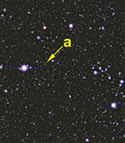
Image credit: Subaru Telescope
The Subaru telescope, based in Japan, has detected the most distant galaxy ever recorded at 12.8 billion light-years away. The Subaru Deep Field project team uncovered 70 candidate distant objects, by using a special filter which only allows light of a very specific wavelength to pass through – one that corresponds to objects which are approximately 13 billion light-years away.
Subaru telescope has found a galaxy 12.8 billion light years away (a redshift of 6.58; see note 1), the most distant galaxy ever observed. This discovery is the first result from the Subaru Deep Field Project, a research project of the Subaru Telescope of the National Astronomical Observatory of Japan which operates the Subaru telescope. The Subaru Deep Field (SDF) project team found approximately 70 distant galaxy candidates by attaching a special filter designed to detect galaxies around 13 billion light years away on a camera with a wide field of view. Follow-up observations with a spectrograph confirmed that two out of nine of the candidates are in fact distant galaxies. One of these is the most distant galaxy ever observed. This discovery raises the expectation that the project will be able to find a large number of distant galaxies that will help unravel the early history of the universe in a statistically meaningful manner.
The SDF project is an observatory project of the National Astronomical Observatory of Japan designed to showcase the abilities of Subaru telescope and to resolve fundamental astronomical questions that are difficult to address through Subaru’s regular time allocation system. Most research programs on Subaru telescope are selected through a competitive time allocation process called Open Use, which is open to all astronomers but allows a maximum of only three observing nights every six months. By pooling together observing nights reserved for the observatory and astronomers that contributed to the establishment of Subaru Telescope, an observatory project can address questions that require greater telescope resources than the typical research proposal. The SDF project’s main goal is to detect a large number of the most distant galaxies detectable and to understand their properties and their impact on the evolution of the universe. The speed of light is the fundamental limit to how fast information can travel (see note 2). When we detect light from a galaxy 13 billion light years away, that means we are seeing the galaxy as it was 13 billion years ago. Looking for ever more distant galaxies means looking at galaxies at earlier and earlier times in the universe.
The SDF observations took advantage of the fact that light from distant galaxies have a characteristic wavelength and shape. Astronomers think that the earliest galaxies rapidly formed stars from hydrogen, the dominant form of matter in the universe. The light from these stars would have excited any hydrogen remaining around them to higher energy states and even ionize it. When excited hydrogen returns to lower energy states, it emits light at several distinct wavelengths. However, most of this light would escape the young galaxy as an emission line at 122 nanometers because “bluer” light with shorter wavelengths and higher energy can re-excite other hydrogen atoms. Since the universe is expanding, the farther away a galaxy is from us, the faster it is moving away from us. Because of this movement, light from distant galaxies are doppler shifted to longer, or redder wavelengths, and this emission line is “redshifted” to a longer wavelength that is characteristic of the galaxy’s distance and the galaxy itself appears redder. As the light travels the long distance from its origin to Earth, light at the higher energy side, or blue side of the emission line, can be absorbed by the neutral hydrogen in intergalactic space. This absorption gives the emission line a distinctive asymmetrical look. A overall red appearance and a strong emission line at a particular wavelength with a particular asymmetrical shape is the signature of a distant new born galaxy.
To detect the most distant galaxies ever observed, the SDF team developed a special filter that only passes light with the narrow wavelength range of 908 to 938 nanometers. These wavelengths correspond to the 122 nanometer emission line after travelling a distance of 13 billion light years. The team installed the special filter, and two other filters at shorter and longer wavelengths bracketing the special filter, on Subaru telescope’s Suprime-Cam, Subaru Prime Focus Camera, and carried out an extensive observing program from April through May 2002. Suprime-Cam has the capability of imaging an area of the sky as large as the full moon in one exposure, a unique capability among instruments on 8-m class and larger telescopes, and is extremely well suited for surveys of very faint objects over large areas of the sky. By observing an area of the sky the size of the moon for up to 5.8 hours in each filter, the team was able to detect over 50,000 objects, including many extremely faint galaxies. By selecting galaxies that were bright only in the special filter and preferentially red, the team found 70 candidates for galaxies at a redshift of 6.6 (or a distance of 13 billion light years; see figure 1).
In June 2002, the team used FOCAS, the Faint Object Camera and Spectrograph on Subaru telescope, to observe 9 of the 70 candidates, and confirmed the generally red appearance and an emission line with a distinctive asymmetry in 2 objects (see figure 2), and determined that their redshifts are 6.58 and 6.54. The light from these galaxies was emitted 12.8 billion years ago when the universe was only 900 million years old. The previously observed most distant galaxy, with a redshift of 6.56, was discovered by looking at a large cluster of galaxies that can amplify light from more distant galaxies with a gravitational lensing effect. (See our press release from May 2002, http://www.naoj.org/Latestnews/200205/UH/index.html.)The SDF observations is the first time multiple galaxies at such a great distance have been observed, and without the help of gravitational lensing. The galaxy with a redshift of 6.58 is the most distant galaxy ever observed.
The SDF team expects to find many more distant galaxies through continued observations. Before the first stars and galaxies formed, the universe was in a stage that Astronomers call “the dark ages of the universe”. Determining when the dark ages ended is one of the most important astronomical questions of our time. Core members of the team, Keiichi Kodaira from the Graduate University of Advanced Studies in Japan, Nobunari Kashikawa from the National Astronomical Observatory of Japan, and Yoshiaki Taniguchi from Tohoku University hope that by detecting a statistically significant number of distant galaxies, they can begin to characterize the galaxies that heralded the end of the universe’s dark ages.
Original Source: Subaru News Release
Photos of Mt. Etna Captured By Four Satellites
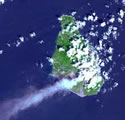
Image credit: NASA
By combining the data from four separate instruments, NASA scientists are able to study the Earth’s volcanoes in tremendous detail. Most recently, Italy’s Mt. Etna was captured mid-eruption using the instruments on board the Terra and Aqua spacecraft, and the data will help the scientists understand the complex behaviour of volcanic plumes and the effects the eruptions have on the environment.
Think of them as the Good Witches of the North, South, East and West, whizzing around the globe daily on their techno “broomsticks” in space. When Europe’s largest, most active volcano, Italy’s Mount Etna, cackled to life and spewed ash and noxious sulfur dioxide gases last October, a quartet of remote sensing instruments from NASA’s Earth Observing System armada flew into action to analyze the smoky, caustic potion.
NASA’s atmospheric science and volcanology wizards can now study the evolution and structure of plumes from Mount Etna and Earth’s 500 or so other active volcanoes in greater detail than ever before. They do this by combining data from the Multi-angle Imaging SpectroRadiometer (Misr), Moderate Resolution Imaging SpectroRadiometer (Modis) and the joint U.S./Japan Advanced Spaceborne Thermal Emission and Reflection Radiometer (Aster) sensors on NASA’s Terra spacecraft with the Atmospheric Infrared Sounder (Airs) and Modis sensors on NASA’s Aqua spacecraft.
“The synergies from NASA’s remote sensing capabilities are helping us understand the complex behavior of volcanic plumes and the effects volcanic eruptions have on the environment,” said Dr. Vince Realmuto, a member of the Earth Observing System volcanology team and supervisor of the Visualization and Scientific Animation Group at NASA’s Jet Propulsion Laboratory, Pasadena, Calif. “By combining data from Airs, Aster, Misr and Modis, we can study volcanic plumes and clouds from many dimensions at once and observe targets of interest like Mount Etna on a daily basis.”
Mount Etna’s most recent eruption, which has subsided but not ended, has released sulfur dioxide into the atmosphere at rates as high as 20,000 metric tons (44.1 million pounds) a day. A major air pollutant vented by some volcanoes, this gas rapidly converts to sulfate aerosols in Earth’s atmosphere, impacting local, regional and global environments.
“At the local and regional level, sulfate aerosols can affect air quality and visibility and cause acid fog and rain, while their small size allows them to penetrate deep into human lungs, impacting respiratory health,” Realmuto said. “To affect global climate, these aerosols have to make their way into Earth’s upper atmosphere, or stratosphere.
“The eruptions of the Philippines’ Mount Pinatubo in 1991 and Mexico’s El Chichon in 1982 deposited aerosols in the stratosphere and had measurable effects on global climate,” Realmuto continued. “These volcanic aerosol layers can reflect incoming solar radiation, resulting in less radiation reaching the ground and throwing off the radiation balance between the Earth, atmosphere and sun. They can trap greenhouse gasses, such as carbon dioxide and water vapor, rising through the atmosphere. They can also lead to the formation of polar stratospheric clouds, a component of the process that destroys Earth’s protective ozone layer.”
Airs, Aster and Modis all collect measurements in the thermal infrared spectrum. Sulfur dioxide, sulfate aerosols and volcanic ash are all easily detectable in this spectral region.
The high spatial resolution of Aster makes it the only orbiting instrument that can detect the non-explosive venting of sulfur dioxide from small volcanic vents. Aster’s visible and near infrared channels can also be used to determine some properties of aerosols and ash. Aster was built by Japan’s Ministry of Economy, Trade and Industry and has a joint U.S./Japan science team.
Airs’ high spectral resolution will allow scientists to identify the components that make up volcanic plumes and estimate the quantity of these components with greater accuracy. In addition, Airs’ atmospheric temperature and relative humidity data will help scientists develop thermal infrared models that can be used to determine ash and aerosol makeup.
Modis’ spatial resolution falls in between that of Aster and Airs. Thus, Modis data are a bridge between the more localized Aster measurements and the more regional Airs data. Since Aster observations of particular targets must be scheduled in advance, Modis often provides the highest spatial resolution thermal infrared data for a given eruption. Both Modis and Airs transmit data in real time-a key to monitoring volcanoes from space.
Misr’s multi-angle imaging allows scientists to identify thin clouds of airborne volcanic ash and aerosol plumes and estimate the abundance and size of the particles. For thicker plumes, Misr can determine the height of the aerosol plume and the speed at which winds are moving the plume through the atmosphere. Knowing the plume height above the ground is important to thermal infrared modeling because it determines the temperature contrast between clouds and their backgrounds. Wind speed data are essential to accurately estimate the rate at which the material is horizontally dispersed into the atmosphere.
Original Source: NASA News Release
Investigators Consider Possible Causes of Shuttle Disaster
NASA investigators have come up with several theories of what could have caused the destruction of the space shuttle Columbia. They’re currently considering whether a block of ice formed on the shuttle’s wing while it was in space. This could have broken off during re-entry and damaged the spacecraft. Another theory suggests that the shuttle collided with a piece of orbital debris.
Hubble Reveals Dumbbell Nebula
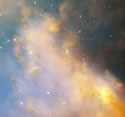
Image credit: Hubble
The latest image from the Hubble Space Telescope reveals a close-up view of planetary nebula M29, aka the Dumbbell Nebula. Featured in the image are knots of gas and dust which astronomers believe appear in all planetary nebula at a certain stage of their creation.
An aging star’s last hurrah is creating a flurry of glowing knots of gas that appear to be streaking through space in this close-up image of the Dumbbell Nebula, taken with NASA’s Hubble Space Telescope.
The Dumbbell, a nearby planetary nebula residing more than 1,200 light-years away, is the result of an old star that has shed its outer layers in a glowing display of color. The nebula, also known as Messier 27 (M27), was the first planetary nebula ever discovered. French astronomer Charles Messier spotted it in 1764.
The Hubble images of the Dumbbell show many knots, but their shapes vary. Some look like fingers pointing at the central star, located just off the upper left of the image; others are isolated clouds, with or without tails. Their sizes typically range from 11 – 35 billion miles (17 – 56 billion kilometers), which is several times larger than the distance from the Sun to Pluto. Each contains as much mass as three Earths.
The knots are forming at the interface between the hot (ionized) and cool (neutral) portion of the nebula. This area of temperature differentiation moves outward from the central star as the nebula evolves. In the Dumbbell astronomers are seeing the knots soon after this hot gas passed by.
Dense knots of gas and dust seem to be a natural part of the evolution of planetary nebulae. They form in the early stages, and their shape changes as the nebula expands. Similar knots have been discovered in other nearby planetary nebulae that are all part of the same evolutionary scheme. They can be seen in Hubble telescope photos of the Ring Nebula (NGC 6720), the Eskimo Nebula (NGC 2392) and the Retina Nebula (IC 4406). The detection of these knots in all the nearby planetaries imaged by the Hubble telescope allows astronomers to hypothesize that knots may be a feature common in all planetary nebulae.
This image, created by the Hubble Heritage Team (STScI), was taken by Hubble’s Wide Field Planetary Camera 2 in November 2001, by Bob O’Dell (Vanderbilt University) and collaborators. The filters used to create this color image show oxygen in blue, hydrogen in green and a combination of sulfur and nitrogen emission in red.
Original Source: Hubble News Release
My Condolences
I just wanted to take a moment and offer my deep and sincere condolences to everyone who was touched by the recent space shuttle tragedy. I had the opportunity to watch portions of the ceremony on NASA TV today (yes, through the Internet), and it filled me with sadness for the heroes who died on Saturday. My thoughts have been on almost nothing else for the past few days, so today kind of felt like closure.
I’m glad that a common theme from the government and NASA has been a renewed commitment to the exploration of space, and I was encouraged by the fact that the NASA budget was largely maintained for the coming year. I think NASA did a much better job of responding to the crisis this time, and I really hope they get to the bottom of what happened. Even though they can’t undo what happened, they can make damn sure it never happens again.
On their newly redesigned website, NASA is maintaining ongoing updates and news about their investigation into the tragedy. Even though we’re all deluged by news of the event in many directions, I would encourage you to check out their site to get the scoop. (http://www.nasa.gov)
Take care,
Fraser Cain
Publisher, Universe Today
